traction control CADILLAC XT5 2019 Owner's Guide
[x] Cancel search | Manufacturer: CADILLAC, Model Year: 2019, Model line: XT5, Model: CADILLAC XT5 2019Pages: 388, PDF Size: 6.29 MB
Page 217 of 388
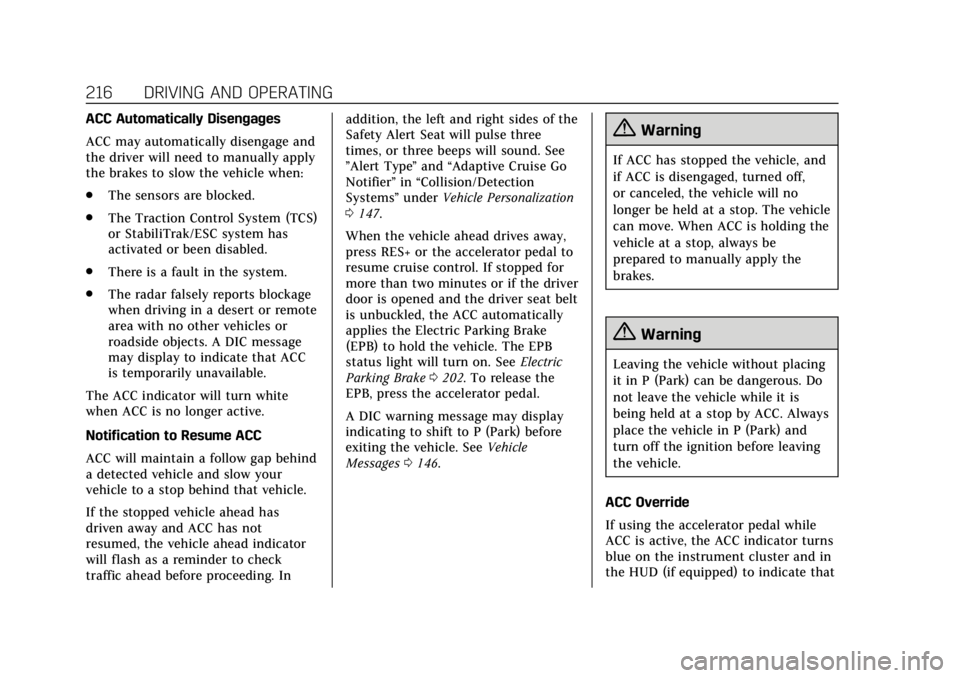
Cadillac XT5 Owner Manual (GMNA-Localizing-U.S./Canada/Mexico-
12146119) - 2019 - crc - 7/27/18
216 DRIVING AND OPERATING
ACC Automatically Disengages
ACC may automatically disengage and
the driver will need to manually apply
the brakes to slow the vehicle when:
.The sensors are blocked.
. The Traction Control System (TCS)
or StabiliTrak/ESC system has
activated or been disabled.
. There is a fault in the system.
. The radar falsely reports blockage
when driving in a desert or remote
area with no other vehicles or
roadside objects. A DIC message
may display to indicate that ACC
is temporarily unavailable.
The ACC indicator will turn white
when ACC is no longer active.
Notification to Resume ACC
ACC will maintain a follow gap behind
a detected vehicle and slow your
vehicle to a stop behind that vehicle.
If the stopped vehicle ahead has
driven away and ACC has not
resumed, the vehicle ahead indicator
will flash as a reminder to check
traffic ahead before proceeding. In addition, the left and right sides of the
Safety Alert Seat will pulse three
times, or three beeps will sound. See
”Alert Type
”and “Adaptive Cruise Go
Notifier” in“Collision/Detection
Systems” underVehicle Personalization
0 147.
When the vehicle ahead drives away,
press RES+ or the accelerator pedal to
resume cruise control. If stopped for
more than two minutes or if the driver
door is opened and the driver seat belt
is unbuckled, the ACC automatically
applies the Electric Parking Brake
(EPB) to hold the vehicle. The EPB
status light will turn on. See Electric
Parking Brake 0202. To release the
EPB, press the accelerator pedal.
A DIC warning message may display
indicating to shift to P (Park) before
exiting the vehicle. See Vehicle
Messages 0146.{Warning
If ACC has stopped the vehicle, and
if ACC is disengaged, turned off,
or canceled, the vehicle will no
longer be held at a stop. The vehicle
can move. When ACC is holding the
vehicle at a stop, always be
prepared to manually apply the
brakes.
{Warning
Leaving the vehicle without placing
it in P (Park) can be dangerous. Do
not leave the vehicle while it is
being held at a stop by ACC. Always
place the vehicle in P (Park) and
turn off the ignition before leaving
the vehicle.
ACC Override
If using the accelerator pedal while
ACC is active, the ACC indicator turns
blue on the instrument cluster and in
the HUD (if equipped) to indicate that
Page 252 of 388

Cadillac XT5 Owner Manual (GMNA-Localizing-U.S./Canada/Mexico-
12146119) - 2019 - crc - 7/27/18
DRIVING AND OPERATING 251
(ITBC) system, and the trailer has an
electric brake system, StabiliTrak/ESC
may also apply the trailer brakes.
If TSC is enabled, the Traction Control
System (TCS)/StabiliTrak/ESC warning
light will flash on the instrument
cluster. Reduce vehicle speed by
gradually removing your foot from the
accelerator. If trailer sway continues,
StabiliTrak/ESC can reduce engine
torque to help slow the vehicle. TSC
will not function if StabiliTrak/ESC is
turned off. SeeTraction Control/
Electronic Stability Control 0205.
{Warning
Trailer sway can result in a crash
and in serious injury or death, even
if the vehicle is equipped with TSC.
(Continued)
Warning (Continued)
If the trailer begins to sway, reduce
vehicle speed by gradually removing
your foot from the accelerator. Then
pull over to check the trailer and
vehicle to help correct possible
causes, including an improperly or
overloaded trailer, unrestrained
cargo, improper trailer hitch
configuration, or improperly
inflated or incorrect vehicle or
trailer tires. SeeTowing Equipment
0 247 for trailer ratings and hitch
setup recommendations.
Trailer Tires
Special Trailer (ST) tires differ from
vehicle tires. Trailer tires are designed
with stiff sidewalls to help prevent
sway and to support heavy loads.
These features can make it difficult to
determine if the trailer tire pressures
are low only based on a visual
inspection. Always check all trailer tire pressures
before each trip when the tires are
cool. Low trailer tire pressure is a
leading cause of trailer tire blow-outs.
Trailer tires deteriorate over time. The
trailer tire sidewall will show the week
and year the tire was manufactured.
Many trailer tire manufacturers
recommend replacing tires more than
six years old.
Overloading is another leading cause
of trailer tire blow-outs. Never load
your trailer with more weight than the
tires are designed to support. The load
rating is located on the trailer tire
sidewall.
Always know the maximum speed
rating for the trailer tires before
driving. This may be significantly
lower than the vehicle tire speed
rating. The speed rating may be on
the trailer tire sidewall. If the speed
rating is not shown, the default trailer
tire speed rating is 105 km/h
(65 mph).
Page 256 of 388
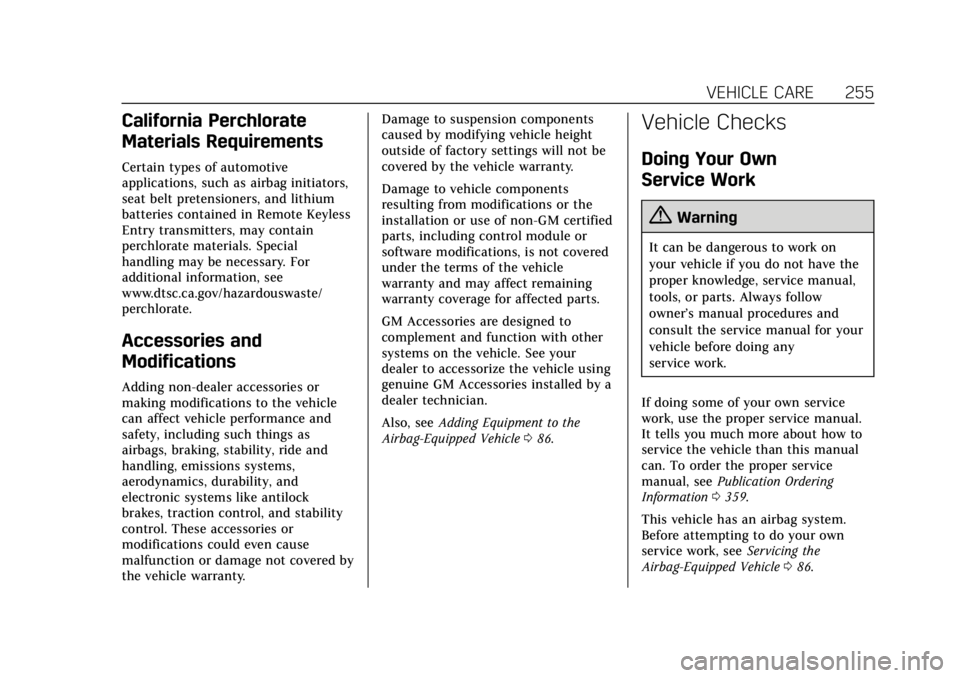
Cadillac XT5 Owner Manual (GMNA-Localizing-U.S./Canada/Mexico-
12146119) - 2019 - crc - 7/27/18
VEHICLE CARE 255
California Perchlorate
Materials Requirements
Certain types of automotive
applications, such as airbag initiators,
seat belt pretensioners, and lithium
batteries contained in Remote Keyless
Entry transmitters, may contain
perchlorate materials. Special
handling may be necessary. For
additional information, see
www.dtsc.ca.gov/hazardouswaste/
perchlorate.
Accessories and
Modifications
Adding non-dealer accessories or
making modifications to the vehicle
can affect vehicle performance and
safety, including such things as
airbags, braking, stability, ride and
handling, emissions systems,
aerodynamics, durability, and
electronic systems like antilock
brakes, traction control, and stability
control. These accessories or
modifications could even cause
malfunction or damage not covered by
the vehicle warranty.Damage to suspension components
caused by modifying vehicle height
outside of factory settings will not be
covered by the vehicle warranty.
Damage to vehicle components
resulting from modifications or the
installation or use of non-GM certified
parts, including control module or
software modifications, is not covered
under the terms of the vehicle
warranty and may affect remaining
warranty coverage for affected parts.
GM Accessories are designed to
complement and function with other
systems on the vehicle. See your
dealer to accessorize the vehicle using
genuine GM Accessories installed by a
dealer technician.
Also, see
Adding Equipment to the
Airbag-Equipped Vehicle 086.
Vehicle Checks
Doing Your Own
Service Work
{Warning
It can be dangerous to work on
your vehicle if you do not have the
proper knowledge, service manual,
tools, or parts. Always follow
owner’s manual procedures and
consult the service manual for your
vehicle before doing any
service work.
If doing some of your own service
work, use the proper service manual.
It tells you much more about how to
service the vehicle than this manual
can. To order the proper service
manual, see Publication Ordering
Information 0359.
This vehicle has an airbag system.
Before attempting to do your own
service work, see Servicing the
Airbag-Equipped Vehicle 086.
Page 301 of 388
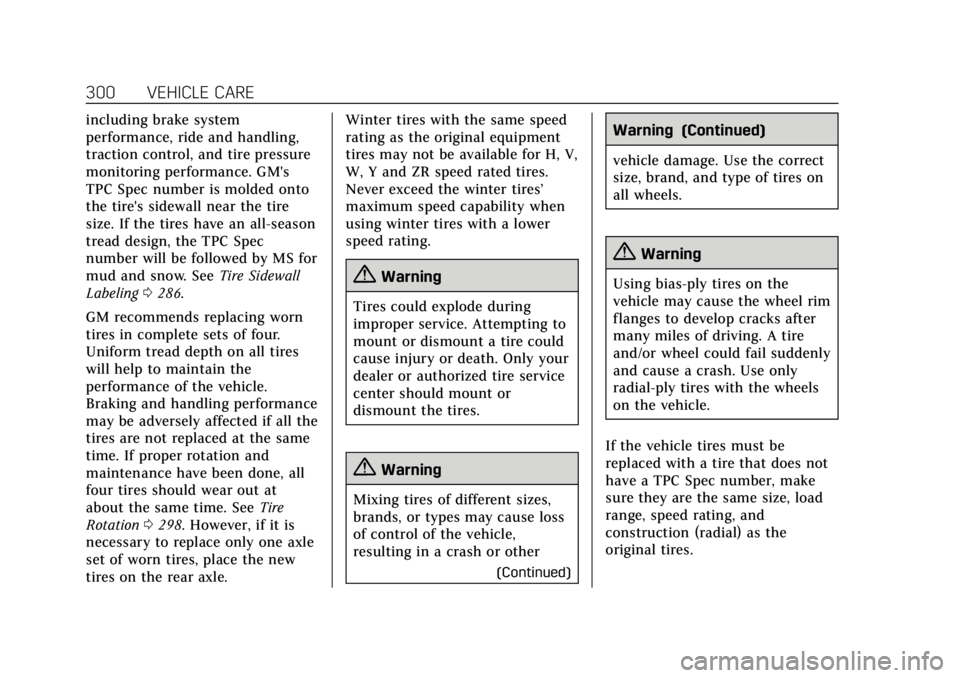
Cadillac XT5 Owner Manual (GMNA-Localizing-U.S./Canada/Mexico-
12146119) - 2019 - crc - 7/27/18
300 VEHICLE CARE
including brake system
performance, ride and handling,
traction control, and tire pressure
monitoring performance. GM's
TPC Spec number is molded onto
the tire's sidewall near the tire
size. If the tires have an all-season
tread design, the TPC Spec
number will be followed by MS for
mud and snow. SeeTire Sidewall
Labeling 0286.
GM recommends replacing worn
tires in complete sets of four.
Uniform tread depth on all tires
will help to maintain the
performance of the vehicle.
Braking and handling performance
may be adversely affected if all the
tires are not replaced at the same
time. If proper rotation and
maintenance have been done, all
four tires should wear out at
about the same time. See Tire
Rotation 0298. However, if it is
necessary to replace only one axle
set of worn tires, place the new
tires on the rear axle. Winter tires with the same speed
rating as the original equipment
tires may not be available for H, V,
W, Y and ZR speed rated tires.
Never exceed the winter tires’
maximum speed capability when
using winter tires with a lower
speed rating.
{Warning
Tires could explode during
improper service. Attempting to
mount or dismount a tire could
cause injury or death. Only your
dealer or authorized tire service
center should mount or
dismount the tires.
{Warning
Mixing tires of different sizes,
brands, or types may cause loss
of control of the vehicle,
resulting in a crash or other
(Continued)
Warning (Continued)
vehicle damage. Use the correct
size, brand, and type of tires on
all wheels.
{Warning
Using bias-ply tires on the
vehicle may cause the wheel rim
flanges to develop cracks after
many miles of driving. A tire
and/or wheel could fail suddenly
and cause a crash. Use only
radial-ply tires with the wheels
on the vehicle.
If the vehicle tires must be
replaced with a tire that does not
have a TPC Spec number, make
sure they are the same size, load
range, speed rating, and
construction (radial) as the
original tires.
Page 302 of 388
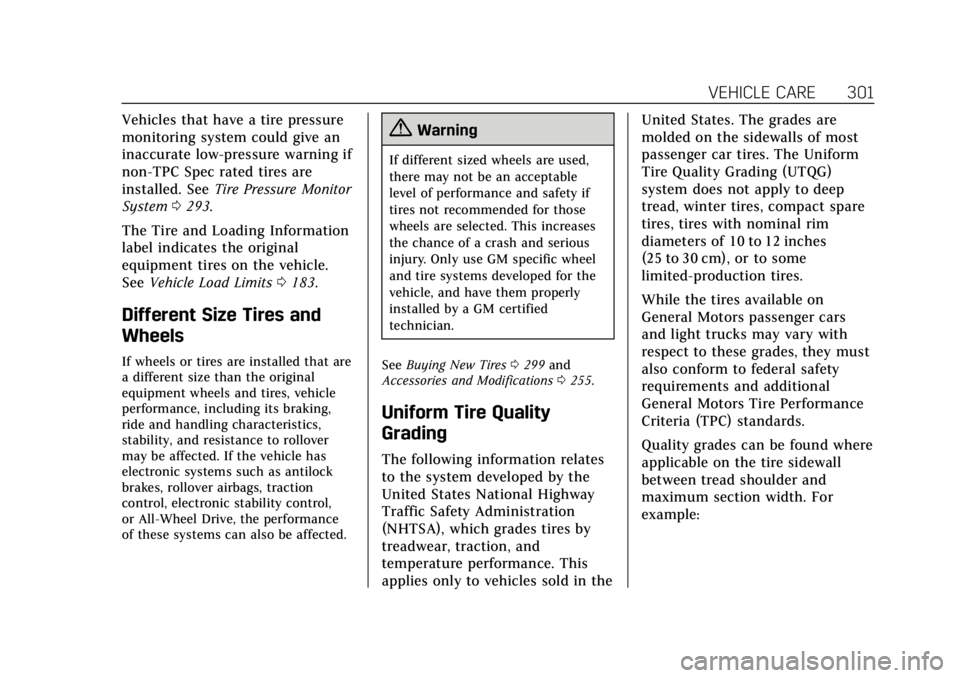
Cadillac XT5 Owner Manual (GMNA-Localizing-U.S./Canada/Mexico-
12146119) - 2019 - crc - 7/27/18
VEHICLE CARE 301
Vehicles that have a tire pressure
monitoring system could give an
inaccurate low-pressure warning if
non-TPC Spec rated tires are
installed. SeeTire Pressure Monitor
System 0293.
The Tire and Loading Information
label indicates the original
equipment tires on the vehicle.
See Vehicle Load Limits 0183.
Different Size Tires and
Wheels
If wheels or tires are installed that are
a different size than the original
equipment wheels and tires, vehicle
performance, including its braking,
ride and handling characteristics,
stability, and resistance to rollover
may be affected. If the vehicle has
electronic systems such as antilock
brakes, rollover airbags, traction
control, electronic stability control,
or All-Wheel Drive, the performance
of these systems can also be affected.
{Warning
If different sized wheels are used,
there may not be an acceptable
level of performance and safety if
tires not recommended for those
wheels are selected. This increases
the chance of a crash and serious
injury. Only use GM specific wheel
and tire systems developed for the
vehicle, and have them properly
installed by a GM certified
technician.
See Buying New Tires 0299 and
Accessories and Modifications 0255.
Uniform Tire Quality
Grading
The following information relates
to the system developed by the
United States National Highway
Traffic Safety Administration
(NHTSA), which grades tires by
treadwear, traction, and
temperature performance. This
applies only to vehicles sold in the United States. The grades are
molded on the sidewalls of most
passenger car tires. The Uniform
Tire Quality Grading (UTQG)
system does not apply to deep
tread, winter tires, compact spare
tires, tires with nominal rim
diameters of 10 to 12 inches
(25 to 30 cm), or to some
limited-production tires.
While the tires available on
General Motors passenger cars
and light trucks may vary with
respect to these grades, they must
also conform to federal safety
requirements and additional
General Motors Tire Performance
Criteria (TPC) standards.
Quality grades can be found where
applicable on the tire sidewall
between tread shoulder and
maximum section width. For
example:
Page 303 of 388
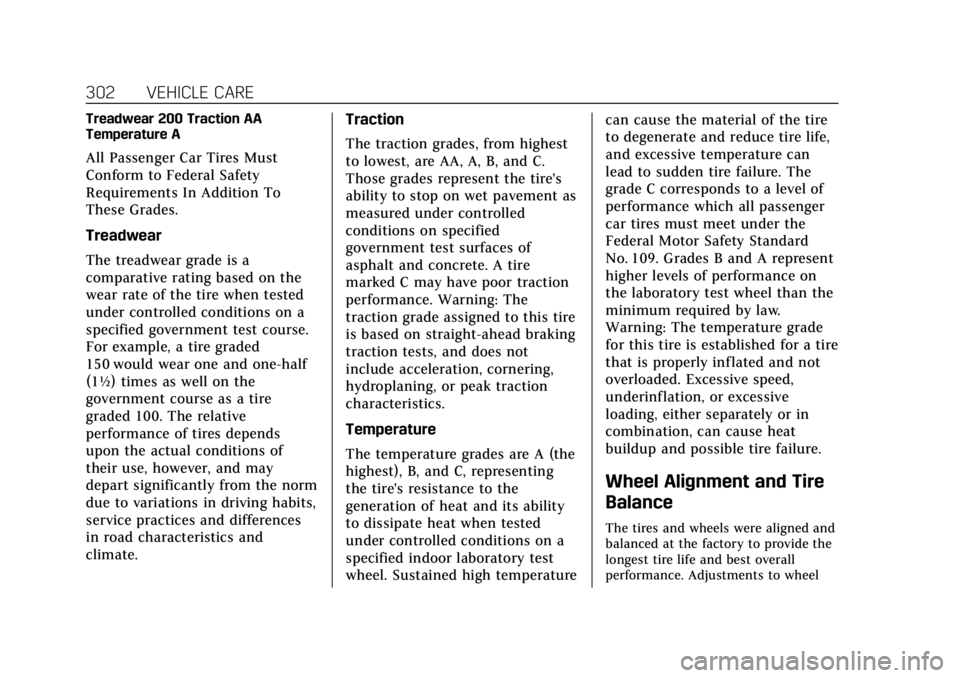
Cadillac XT5 Owner Manual (GMNA-Localizing-U.S./Canada/Mexico-
12146119) - 2019 - crc - 7/27/18
302 VEHICLE CARE
Treadwear 200 Traction AA
Temperature A
All Passenger Car Tires Must
Conform to Federal Safety
Requirements In Addition To
These Grades.
Treadwear
The treadwear grade is a
comparative rating based on the
wear rate of the tire when tested
under controlled conditions on a
specified government test course.
For example, a tire graded
150 would wear one and one-half
(1½) times as well on the
government course as a tire
graded 100. The relative
performance of tires depends
upon the actual conditions of
their use, however, and may
depart significantly from the norm
due to variations in driving habits,
service practices and differences
in road characteristics and
climate.Traction
The traction grades, from highest
to lowest, are AA, A, B, and C.
Those grades represent the tire's
ability to stop on wet pavement as
measured under controlled
conditions on specified
government test surfaces of
asphalt and concrete. A tire
marked C may have poor traction
performance. Warning: The
traction grade assigned to this tire
is based on straight-ahead braking
traction tests, and does not
include acceleration, cornering,
hydroplaning, or peak traction
characteristics.
Temperature
The temperature grades are A (the
highest), B, and C, representing
the tire's resistance to the
generation of heat and its ability
to dissipate heat when tested
under controlled conditions on a
specified indoor laboratory test
wheel. Sustained high temperaturecan cause the material of the tire
to degenerate and reduce tire life,
and excessive temperature can
lead to sudden tire failure. The
grade C corresponds to a level of
performance which all passenger
car tires must meet under the
Federal Motor Safety Standard
No. 109. Grades B and A represent
higher levels of performance on
the laboratory test wheel than the
minimum required by law.
Warning: The temperature grade
for this tire is established for a tire
that is properly inflated and not
overloaded. Excessive speed,
underinflation, or excessive
loading, either separately or in
combination, can cause heat
buildup and possible tire failure.
Wheel Alignment and Tire
Balance
The tires and wheels were aligned and
balanced at the factory to provide the
longest tire life and best overall
performance. Adjustments to wheel
Page 305 of 388

Cadillac XT5 Owner Manual (GMNA-Localizing-U.S./Canada/Mexico-
12146119) - 2019 - crc - 7/27/18
304 VEHICLE CARE
Tire Chains
{Warning
If the vehicle has a tire size other
than 235/65R18, do not use tire
chains. There is not enough
clearance. Tire chains used on a
vehicle without the proper amount
of clearance can cause damage to
the brakes, suspension, or other
vehicle parts. The area damaged by
the tire chains could cause loss of
control and a crash. Use another
type of traction device only if its
manufacturer recommends it for
the vehicle's tire size combination
and road conditions. Follow that
manufacturer's instructions. To
avoid vehicle damage, drive slow
and readjust or remove the traction
device if it contacts the vehicle. Do
not spin the wheels. If traction
devices are used, install them on
the front tires.
Caution
If the vehicle is equipped with 235/
65R18 size tires, use tire chains
only where legal and only when
necessary. Use low profile chains
that add no more than 12 mm
thickness to the tire tread and inner
sidewall. Use chains that are the
proper size for the tires. Install
them on the tires of the front axle.
Do not use chains on the tires of
the rear axle. Tighten them as
tightly as possible with the ends
securely fastened. Drive slowly and
follow the chain manufacturer's
instructions. If the chains contact
the vehicle, stop and retighten
them. If the contact continues, slow
down until it stops. Driving too fast
or spinning the wheels with chains
on will damage the vehicle.
If a Tire Goes Flat
It is unusual for a tire to blow out
while driving, especially if the tires are
maintained properly. SeeTires0284. If air goes out of a tire, it is much
more likely to leak out slowly. But if
there is ever a blowout, here are a few
tips about what to expect and what
to do:
If a front tire fails, the flat tire creates
a drag that pulls the vehicle toward
that side. Take your foot off the
accelerator pedal and grip the steering
wheel firmly. Steer to maintain lane
position, and then gently brake to a
stop, well off the road, if possible.
A rear blowout, particularly on a
curve, acts much like a skid and may
require the same correction as used in
a skid. Stop pressing the accelerator
pedal and steer to straighten the
vehicle. It may be very bumpy and
noisy. Gently brake to a stop, well off
the road, if possible.
{Warning
Driving on a flat tire will cause
permanent damage to the tire.
Re-inflating a tire after it has been
driven on while severely
(Continued)
Page 319 of 388

Cadillac XT5 Owner Manual (GMNA-Localizing-U.S./Canada/Mexico-
12146119) - 2019 - crc - 7/27/18
318 VEHICLE CARE
Compact Spare Tire
{Warning
Driving with more than one
compact spare tire at a time could
result in loss of braking and
handling. This could lead to a crash
and you or others could be injured.
Use only one compact spare tire at
a time.
If this vehicle has a compact spare
tire, it was fully inflated when new;
however, it can lose air over time.
Check the inflation pressure regularly.
It should be 420 kPa (60 psi).
Stop as soon as possible and check
that the spare tire is correctly inflated
after being installed on the vehicle.
The compact spare tire is designed for
temporary use only. The vehicle will
perform differently with the spare tire
installed and it is recommended that
the vehicle speed be limited to
80 km/h (50 mph). To conserve the
tread of the spare tire, have the standard tire repaired or replaced as
soon as convenient and return the
spare tire to the storage area.
When using a compact spare tire, the
AWD (if equipped), ABS, and Traction
Control systems may engage until the
spare tire is recognized by the vehicle,
especially on slippery roads. Adjust
driving to reduce possible wheel slip.
Caution
When the compact spare is
installed, do not take the vehicle
through an automatic car wash
with guide rails. The compact spare
can get caught on the rails which
can damage the tire, wheel, and
other parts of the vehicle.
Do not use the compact spare on
other vehicles.
Do not mix the compact spare tire or
wheel with other wheels or tires. They
will not fit. Keep the spare tire and its
wheel together.
Caution
Tire chains will not fit the compact
spare. Using them can damage the
vehicle and the chains. Do not use
tire chains on the compact spare.
Page 379 of 388

Cadillac XT5 Owner Manual (GMNA-Localizing-U.S./Canada/Mexico-
12146119) - 2019 - crc - 7/27/18
378 INDEX
Collision Damage Repair . . . . . . . . . . . 357
Compact Spare Tire . . . . . . . . . . . . . . . . . 318
CompartmentsStorage . . . . . . . . . . . . . . . . . . . . . . . . . . . . 106
Compass . . . . . . . . . . . . . . . . . . . . . . . . . . . . . 116
Compressor Kit, Tire Sealant . . . . . . . 306
Connected Services Connections . . . . . . . . . . . . . . . . . . . . . . . 373
Diagnostics . . . . . . . . . . . . . . . . . . . . . . . . 375
Navigation . . . . . . . . . . . . . . . . . . . . . . . . . 372
Connections
Connected Services . . . . . . . . . . . . . . . 373
Control Traction and ElectronicStability . . . . . . . . . . . . . . . . . . . . . . . . . . 205
Control of a Vehicle . . . . . . . . . . . . . . . . 178
Convenience Net . . . . . . . . . . . . . . . . . . . . 110
Convex Mirrors . . . . . . . . . . . . . . . . . . . . . . 48
Coolant
Engine Temperature Gauge . . . . . . 128
Engine Temperature WarningLight . . . . . . . . . . . . . . . . . . . . . . . . . . . . . 137
Cooling . . . . . . . . . . . . . . . . . . . . . . . . .167, 172
Cooling System . . . . . . . . . . . . . . . . . . . . . 262
Cornering Lamps . . . . . . . . . . . . . . . . . . . 163
Courtesy Lamps . . . . . . . . . . . . . . . . . . . . . 163
Courtesy Transportation Program . . . . . . . . . . . . . . . . . . . . . . . . . . . . 356 Cover
Cargo . . . . . . . . . . . . . . . . . . . . . . . . . . . . . . 108
Cruise Control . . . . . . . . . . . . . . . . . . . . . . . 208 Light . . . . . . . . . . . . . . . . . . . . . . . . . . . . . . . 140
Cruise Control, Adaptive . . . . . . . . . . . 210
Cupholders . . . . . . . . . . . . . . . . . . . . . . . . . . 106
Customer Assistance . . . . . . . . . . . . . . . 352 Offices . . . . . . . . . . . . . . . . . . . . . . . . . . . . . 352
Text Telephone (TTY) Users . . . . . 352
Customer Information Publications Ordering
Information . . . . . . . . . . . . . . . . . . . . . . 359
Customer Satisfaction Procedure . . . . . . . . . . . . . . . . . . . . . . . . . . 350
D
Damage Repair, Collision . . . . . . . . . . . 357
Danger, Warning, and Caution . . . . . . . . 3
Data CollectionInfotainment System . . . . . . . . . . . . . 363
OnStar . . . . . . . . . . . . . . . . . . . . . . . . . . . . . 362
Data Recorders, Event . . . . . . . . . . . . . . 361
Daytime Running Lamps (DRL) . . . 161
Defensive Driving . . . . . . . . . . . . . . . . . . . 178
Delayed Locking . . . . . . . . . . . . . . . . . . . . . 38
Diagnostics Connected Services . . . . . . . . . . . . . . . 375
Distracted Driving . . . . . . . . . . . . . . . . . . 177 Dome Lamps . . . . . . . . . . . . . . . . . . . . . . . . 163
Door
Ajar Light . . . . . . . . . . . . . . . . . . . . . . . . . 140
Delayed Locking . . . . . . . . . . . . . . . . . . . . 38
Locks . . . . . . . . . . . . . . . . . . . . . . . . . . . . . . . . 35
Power Locks . . . . . . . . . . . . . . . . . . . . . . . . . 38
Drive Belt Routing, Engine . . . . . . . . . 349
Drive Systems
All-Wheel Drive . . . . . . . . . . . . . . 201, 270
Driver Assistance Systems . . . . . . . . . 219
Driver Information Center (DIC) . . . . . . . . . . . . . . . . . . . . . . . 140
Driver Mode Control . . . . . . . . . . . . . . . . 207
Driving Assistance Systems . . . . . . . . . . . . . . . 226
Characteristics andTowing Tips . . . . . . . . . . . . . . . . . . . . . 240
Defensive . . . . . . . . . . . . . . . . . . . . . . . . . . 178
Drunk . . . . . . . . . . . . . . . . . . . . . . . . . . . . . . 178
For Better Fuel Economy . . . . . . . . . . . 25
Hill and Mountain Roads . . . . . . . . 181
If the Vehicle is Stuck . . . . . . . . . . . . 183
Loss of Control . . . . . . . . . . . . . . . . . . . . 180
Off-Road Recovery . . . . . . . . . . . . . . . . 179
Vehicle Load Limits . . . . . . . . . . . . . . 183
Wet Roads . . . . . . . . . . . . . . . . . . . . . . . . . 180
Winter . . . . . . . . . . . . . . . . . . . . . . . . . . . . . 181
Page 382 of 388

Cadillac XT5 Owner Manual (GMNA-Localizing-U.S./Canada/Mexico-
12146119) - 2019 - crc - 7/27/18
INDEX 381
J
Jump Starting - North America . . . . 319
K
Keyless EntryRemote (RKE) System . . . . . . . . . . . . . . 27
Keys . . . . . . . . . . . . . . . . . . . . . . . . . . . . . . . . . . 26
L
Labeling, Tire Sidewall . . . . . . . . . . . . . 286
Lamps Cornering . . . . . . . . . . . . . . . . . . . . . . . . . . 163
Courtesy . . . . . . . . . . . . . . . . . . . . . . . . . . . 163
Daytime Running (DRL) . . . . . . . . . . 161
Dome . . . . . . . . . . . . . . . . . . . . . . . . . . . . . . 163
Exterior Controls . . . . . . . . . . . . . . . . . . 159
Exterior Lamps Off Reminder . . . . 161
Exterior Lighting BatterySaver . . . . . . . . . . . . . . . . . . . . . . . . . . . . . 165
Malfunction Indicator (Check Engine) . . . . . . . . . . . . . . . . . . . . . . . . . . 132
On Reminder . . . . . . . . . . . . . . . . . . . . . . 139
Reading . . . . . . . . . . . . . . . . . . . . . . . . . . . . 164
Lane Change Alert (LCA) . . . . . . . . . . . 233
Lane Departure Warning (LDW) . . . . . . . . . . . . . . . . . . . 235
Lane Keep Assist (LKA) . . . . . . . . . . . . 235
Lane Keep Assist Light . . . . . . . . . . . . . 136
Lap-Shoulder Belt . . . . . . . . . . . . . . . . . . . . 71 LATCH System
Replacing Parts after a Crash . . . . 100
LATCH, Lower Anchors and Tethers for Children . . . . . . . . . . . . . . . 95
LED Lighting . . . . . . . . . . . . . . . . . . . . . . . . 274
Liftgate . . . . . . . . . . . . . . . . . . . . . . . . . . . . . . . 40
Lighter, Cigarette . . . . . . . . . . . . . . . . . . . 120
Lighting Entry . . . . . . . . . . . . . . . . . . . . . . . . . . . . . . 164
Exit . . . . . . . . . . . . . . . . . . . . . . . . . . . . . . . . 165
Illumination Control . . . . . . . . . . . . . . 163
LED . . . . . . . . . . . . . . . . . . . . . . . . . . . . . . . . 274
Lights Airbag Readiness . . . . . . . . . . . . . . . . . 131
Antilock Brake System (ABS)Warning . . . . . . . . . . . . . . . . . . . . . . . . . 135
Brake System Warning . . . . . . . . . . . 134
Charging System . . . . . . . . . . . . . . . . . . 132
Check Engine (Malfunction Indicator) . . . . . . . . . . . . . . . . . . . . . . . . 132
Cruise Control . . . . . . . . . . . . . . . . . . . . . 140
Door Ajar . . . . . . . . . . . . . . . . . . . . . . . . . . 140
Electric Parking Brake . . . . . . . . . . . . 135
Engine Coolant Temperature Warning . . . . . . . . . . . . . . . . . . . . . . . . . 137
Engine Oil Pressure . . . . . . . . . . . . . . . 138
Flash-to-Pass . . . . . . . . . . . . . . . . . . . . . . 161
High-Beam On . . . . . . . . . . . . . . . . . . . . 139 Lights (cont'd)
High/Low Beam Changer . . . . . . . . . 161
Lane Keep Assist . . . . . . . . . . . . . . . . . . 136
Low Fuel Warning . . . . . . . . . . . . . . . . 139
Seat Belt Reminders . . . . . . . . . . . . . . 130
Security . . . . . . . . . . . . . . . . . . . . . . . . . . . . 139
Service Electric Parking Brake . . . 135
StabiliTrak OFF . . . . . . . . . . . . . . . . . . . 137
Tire Pressure . . . . . . . . . . . . . . . . . . . . . . 138
Traction Control System
(TCS)/StabiliTrak . . . . . . . . . . . . . . . . 137
Traction Off . . . . . . . . . . . . . . . . . . . . . . . 136
Locks Automatic Door . . . . . . . . . . . . . . . . . . . . . 38
Delayed Locking . . . . . . . . . . . . . . . . . . . . 38
Door . . . . . . . . . . . . . . . . . . . . . . . . . . . . . . . . . 35
Lockout Protection . . . . . . . . . . . . . . . . . 38
Power Door . . . . . . . . . . . . . . . . . . . . . . . . . . 38
Safety . . . . . . . . . . . . . . . . . . . . . . . . . . . . . . . . 39
Loss of Control . . . . . . . . . . . . . . . . . . . . . . 180
Low Fuel Warning Light . . . . . . . . . . . 139
Lower Anchors and Tethers for Children (LATCH System) . . . . . . . . . 95
Lumbar Adjustment . . . . . . . . . . . . . . . . . 60 Front Seats . . . . . . . . . . . . . . . . . . . . . . . . . . 60